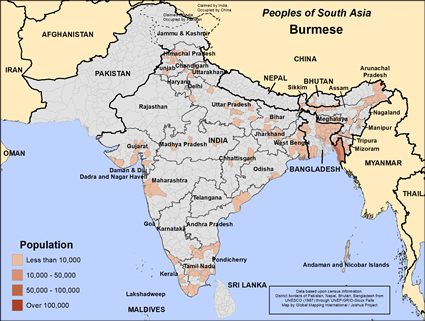Burmese in Bangladesh

Photo Source:
Anonymous
|

Map Source:
People Group data: Omid. Map geography: UNESCO / GMI. Map Design: Joshua Project.
|
| People Name: | Burmese |
| Country: | Bangladesh |
| 10/40 Window: | Yes |
| Population: | 83,000 |
| World Population: | 30,754,900 |
| Primary Language: | Burmese |
| Primary Religion: | Buddhism |
| Christian Adherents: | 0.09 % |
| Evangelicals: | 0.05 % |
| Scripture: | Complete Bible |
| Ministry Resources: | Yes |
| Jesus Film: | Yes |
| Audio Recordings: | Yes |
| People Cluster: | Burmese |
| Affinity Bloc: | Tibetan-Himalayan Peoples |
| Progress Level: |
|
Introduction / History
Burmese civilization probably goes back 3500 years in the Irawaddy Valley, where people were using bronze tools, growing rice and raising livestock. By the 500s, they had adopted Buddhism, which was a turning point for their culture. In the 1000s, the Bama people arrived from the hills of Tibet, and King Anawrahta unified Burma as a nation in 1057. Other kings followed who established Buddhist pagodas, monasteries, libraries, and even places of higher learning. They could control their water supply in such a way that they increased their rice harvests. This civilization waned in the 1300s partly because they gave too much of their resources to the Buddhist monks. This left them more vulnerable to the ravishes of the Mongol Empire and the Tatars. It took another 200 years before a new, expansionist Burmese leader arose, Bayinnaung. He unified Burma for a short time through conquest. After his death, sections of his empire broke away. The Burmese expanded in the early 1800s, but the Chinese stopped them. Soon the British Empire made Burma a province of India for a season.
Today, the Burmese are the political, economic and religious leaders of Myanmar. Myanmar has had a long history of coups, wars and rebellions. Ethnic divisions and political unrest have been common since the first Burmese kingdom in the eleventh century. Today, the Burmese military maintains forcible control over the ethnic groups who want equal power in the government and in commerce. The military promises a ceasefire, but they attack at the slightest note of rebellion. The ethnic groups of Myanmar, including the Burmese majority, have lived in a constant state of instability and fear. Thousands have fled to nearby Asian countries like Cambodia, China, Sri Lanka, India, and especially nearby Bangladesh. They are not to be confused with the Rohingya people.
What Are Their Lives Like?
Rice is the basic means of economic support for the Burmese in Bangladesh. Each day, entire families, including mothers with their babies, toddlers, and old people, go to the rice fields to work. They use oxen and water buffaloes to draw the heavy wooden plows. They seldom have access to modern farm equipment.
Fish is also an important part of their diet, especially for those living near the coast or rivers. They seldom eat meat because of its high cost.
The Burmese farmers live in villages among trees, along roads or near rivers. They build houses entirely out of wood and usually have only one room. The Burmese put mats on the floor to sleep on at night, then rolled them or stacked them away during the day. All activities take place on the dirt floors. Therefore, it is extremely impolite to enter a Burmese house wearing shoes.
The Burmese do not recognize clans or lineages. Marriages are monogamous and rarely arranged by the parents. They encourage young couples to live together and only marry after the girl becomes pregnant. Newlyweds live with the bride's parents for the first few two or three years after marriage. Then they set up their own homes.
What Are Their Beliefs?
The Burmese are predominantly Buddhists. The traditional goal in Buddhism is to seek the middle path to nirvana, or ultimate peace. The Burmese have mixed these Buddhist beliefs with their own animistic beliefs (the belief that non-living objects have spirits).
Like other Buddhists, the Burmese believe that death is not a threat to one who has done good deeds. Instead, death is simply a "passing" from one life to another. They believe that "rebirth" is determined by the accumulated good or bad deeds done in the previous life. Therefore, those who have earned less merit are reborn as demons, ghosts, animals, or inhabitants of hell.
Their animistic beliefs center around inherently evil spirits called nats. The Burmese spend their lives trying to appease the nats so that they will be protected from other evil spirits that may seek to harm them. All Burmese homes have altars for the spirits, as well as a statue of Buddha.
What Are Their Needs?
No matter where they live the Burmese need a peaceful and stable place to live and raise their children. They are denied that in the home country. They need to find it elsewhere.
Prayer Points
Pray that the sheer wonder of knowing Jesus and the impact he has on their lives and the joy he brings spur believers to share Christ with the Burmese people in Bangladesh.
Pray the hearts of the Burmese people would be stirred by a sovereign work of the Holy Spirit readying them for the time when they hear the gospel message being shared with them.
Pray they will experience dreams and visions of Jesus leading them into a saving relationship with him.
Pray for an unstoppable movement to Christ among the Burmese people in Bangladesh.